Synthesis of reduced graphene oxide - Mn₀.₈Zn₀.₂Fe₂O₄ - porous polyaniline nanocomposite materials for effective microwave absorption in X-band
In this paper, a composite of reduced graphene oxide (RGO), manganese/zinc ferrite
(Mn0.8Zn0.2Fe2O4 - MZF) nanoparticles, and porous polyaniline (PANI) was successfully
synthesized to improve microwave absorption properties exclusively in X-band. The
experimental results demonstrate that the synthesized ternary composite had RGO
nanosheets decorated mostly with MZF nanoparticles, and porous PANI was uniformly
coated onto the surface of RGO-MZF. The strong reflection loss value of -60.4 dB at
10 GHz and wide effective bandwidth are effectively achieved with the sample which had
thicknesses of 2 mm and contained 33 weight % of product. The marked display of
the microwave absorption properties of this composite was associated with their
notable structure.
Keywords: Ferrite; graphene; polyaniline; absorber.

Trang 1

Trang 2
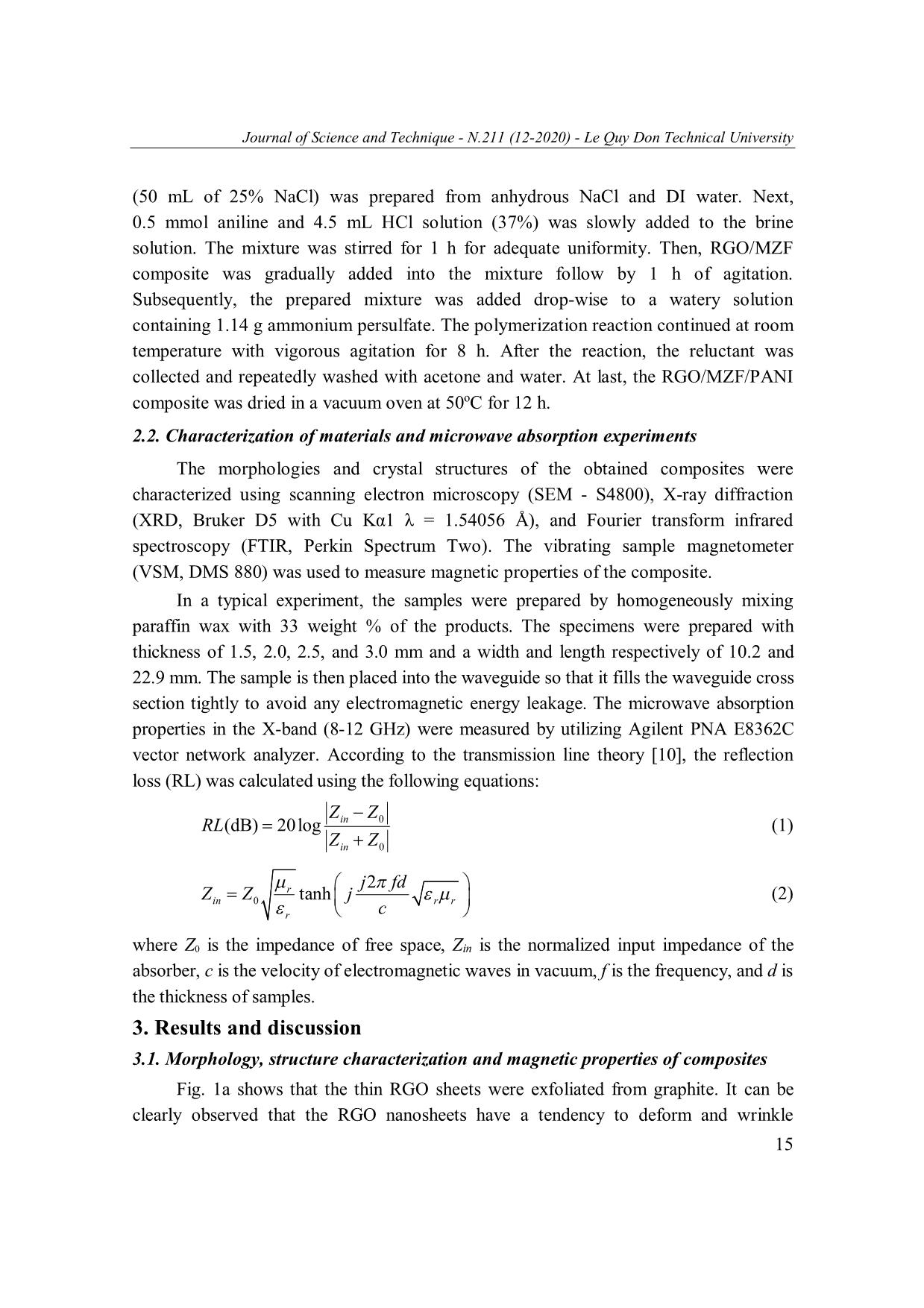
Trang 3
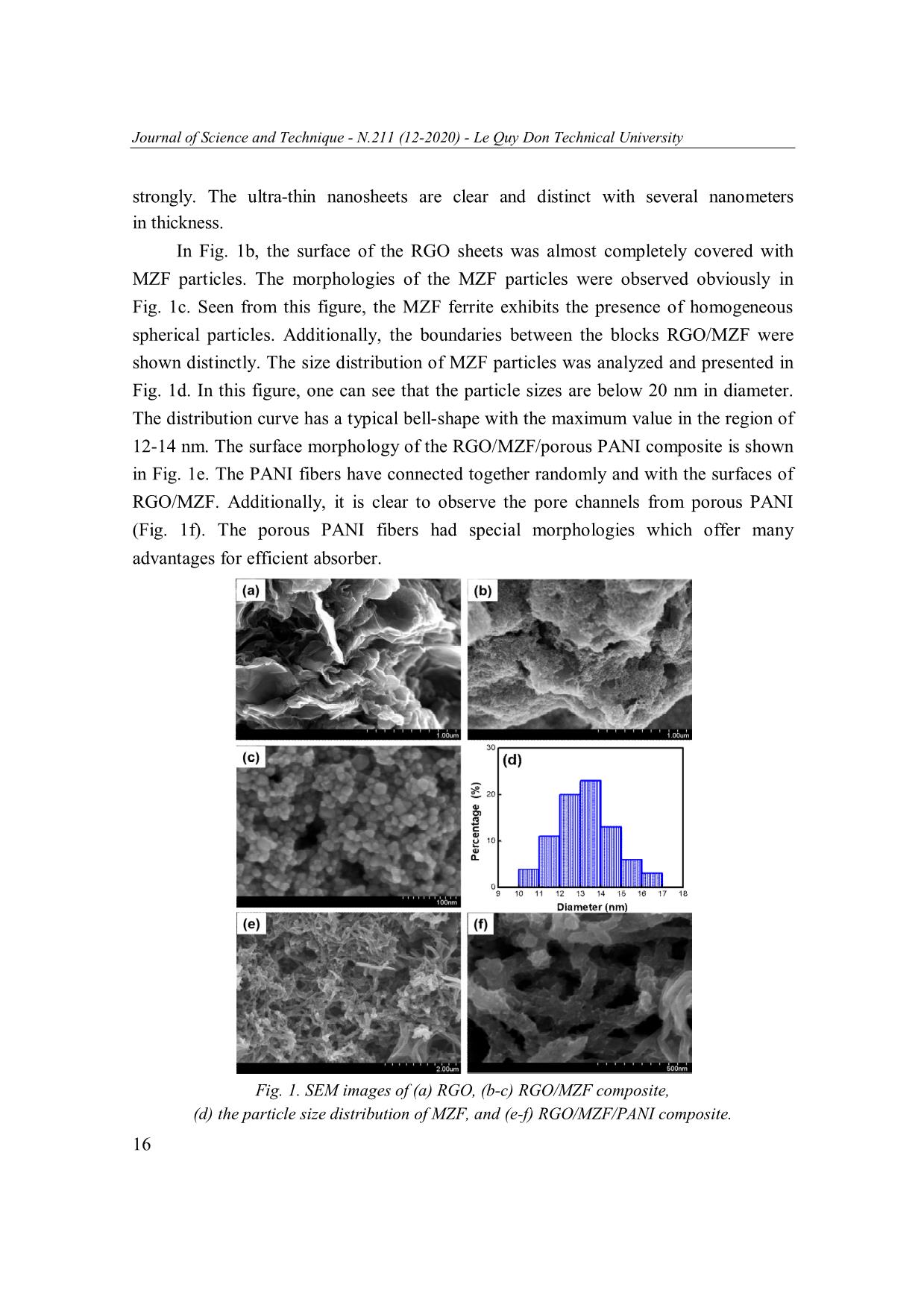
Trang 4
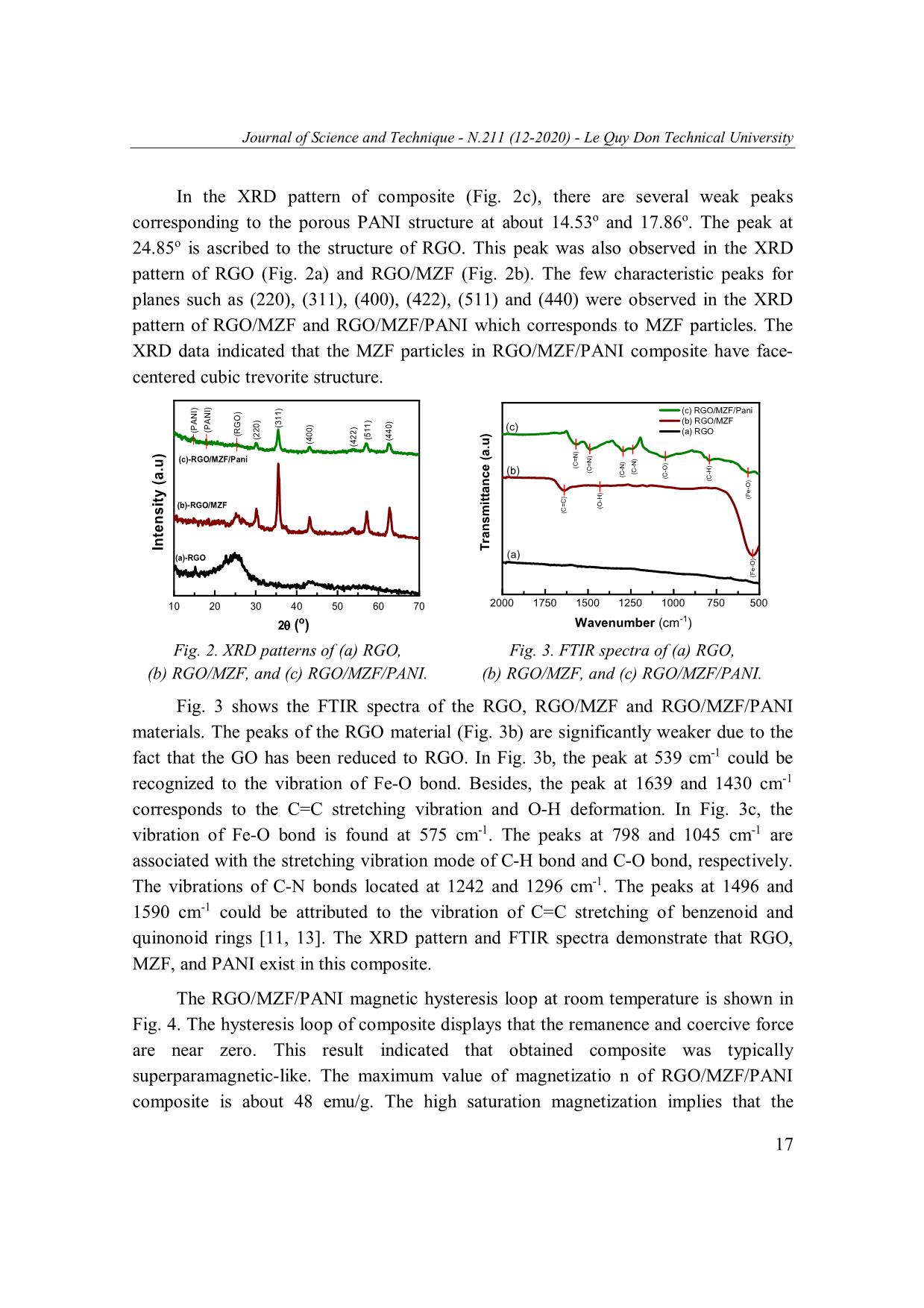
Trang 5
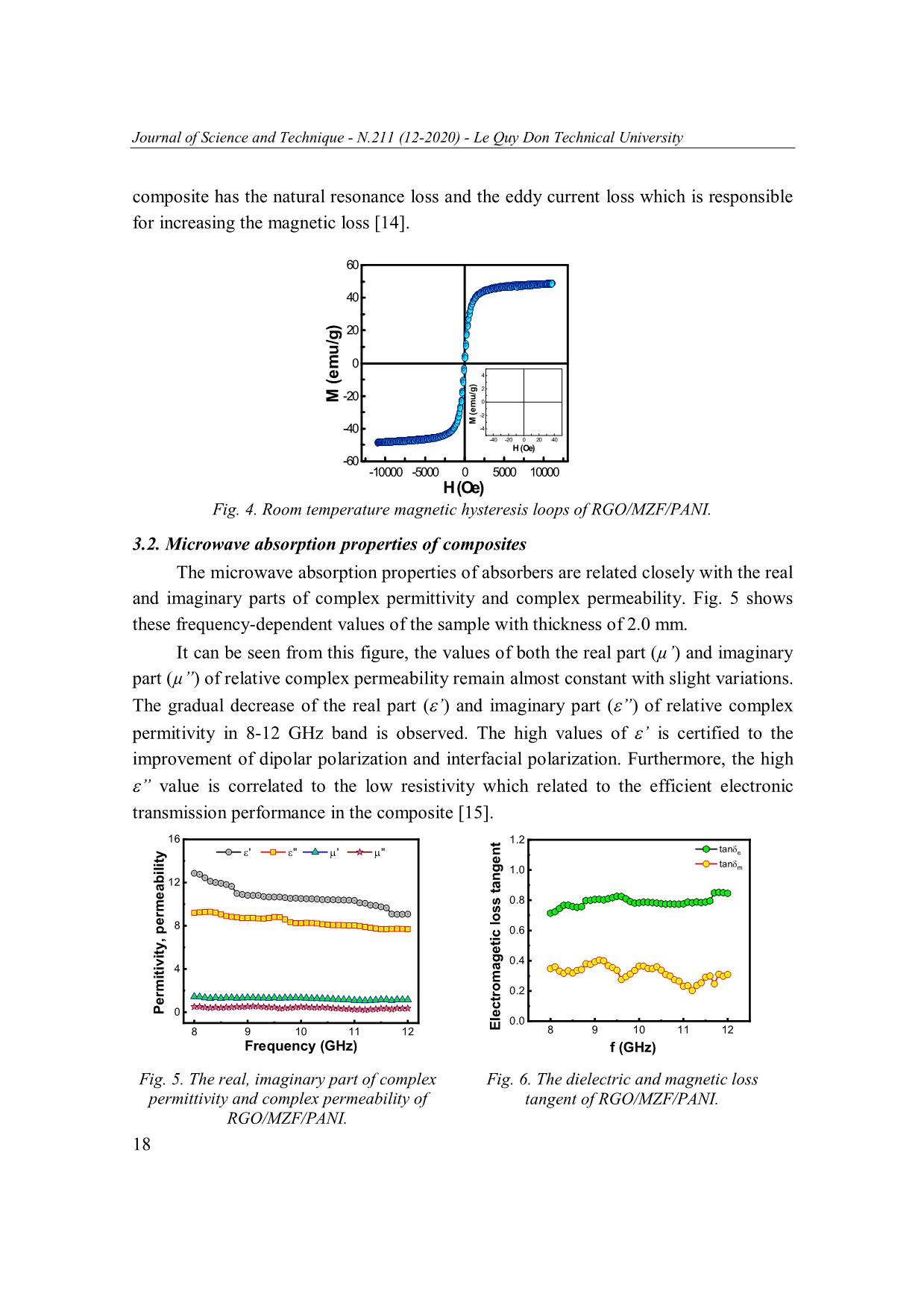
Trang 6
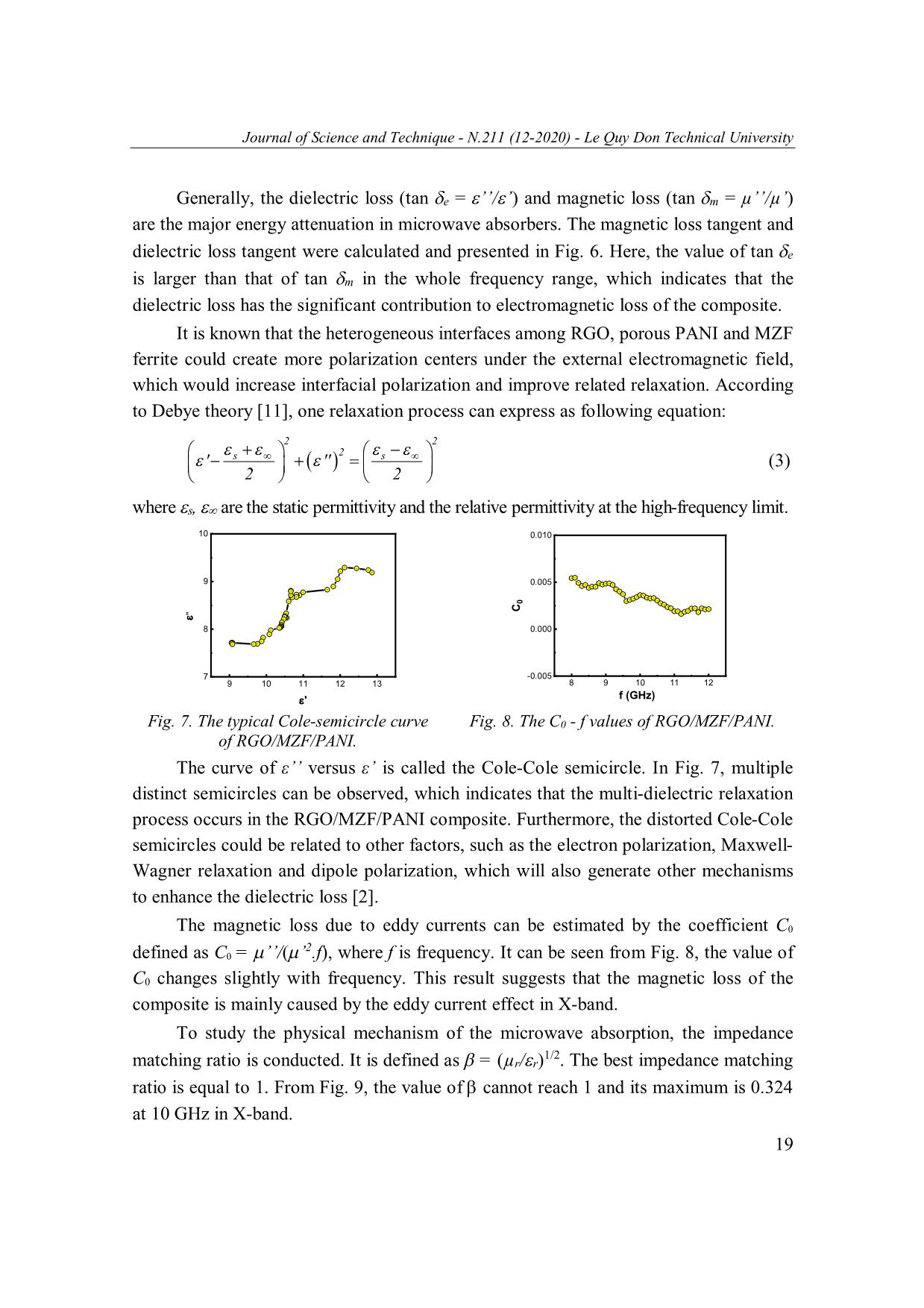
Trang 7
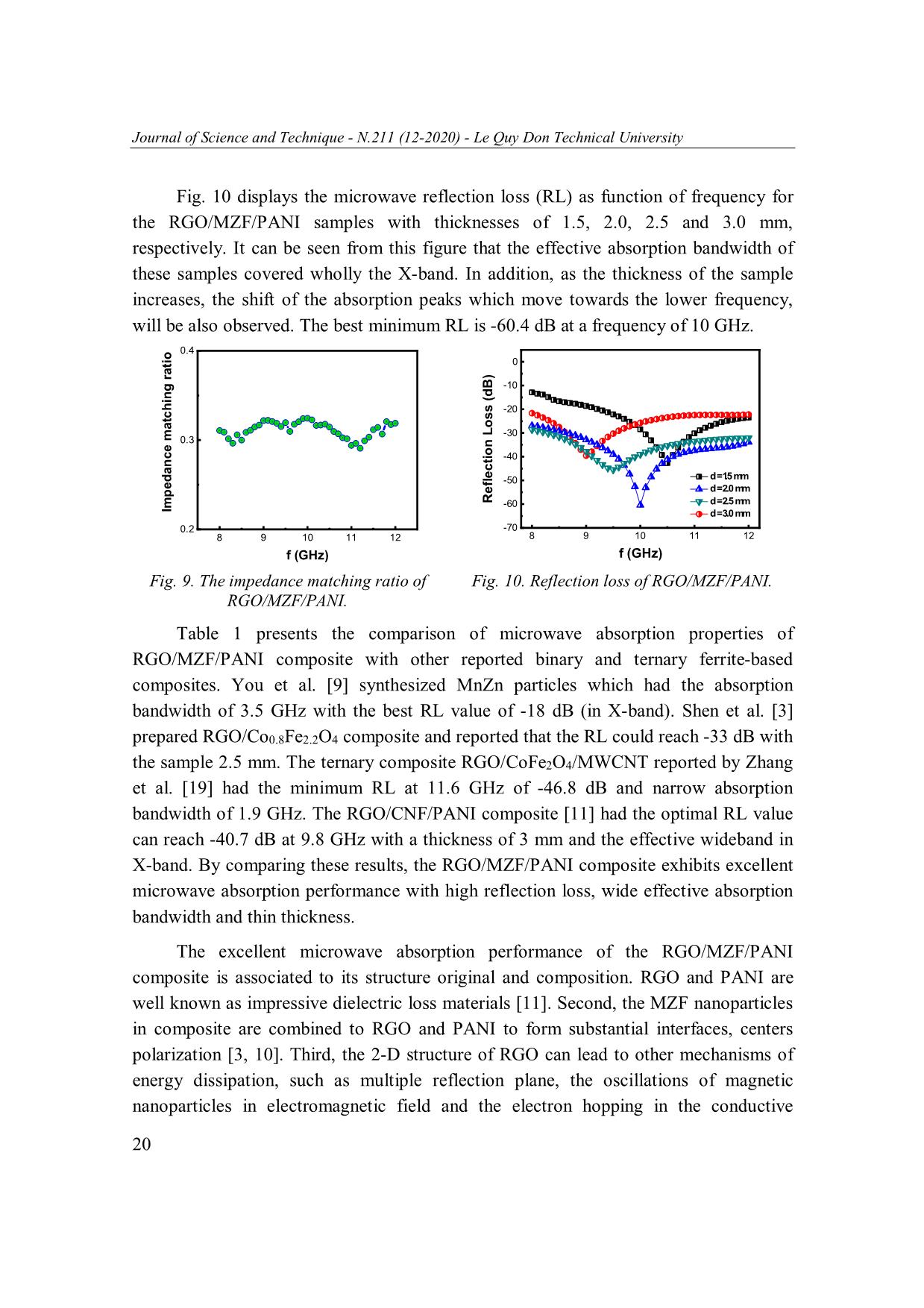
Trang 8
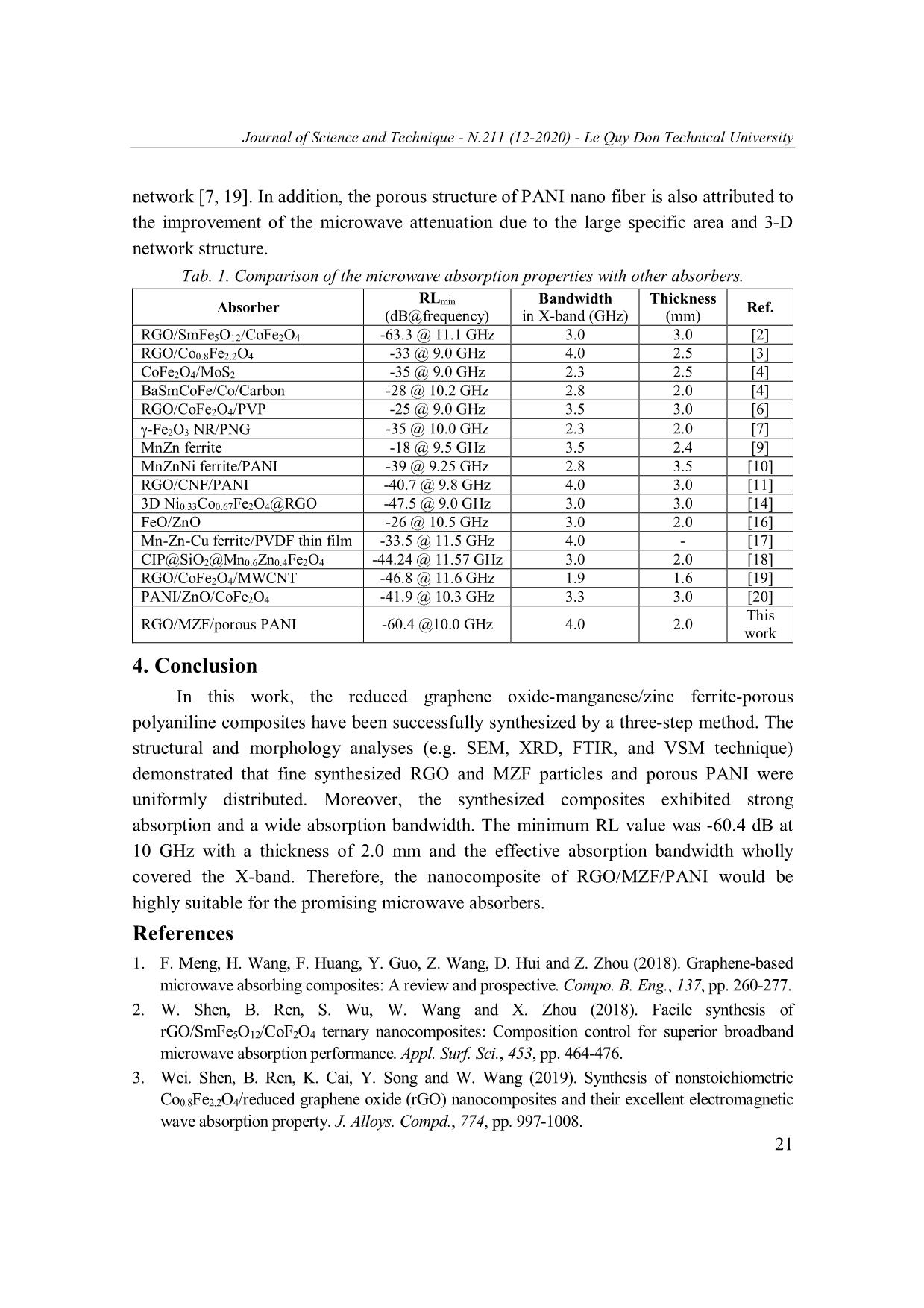
Trang 9
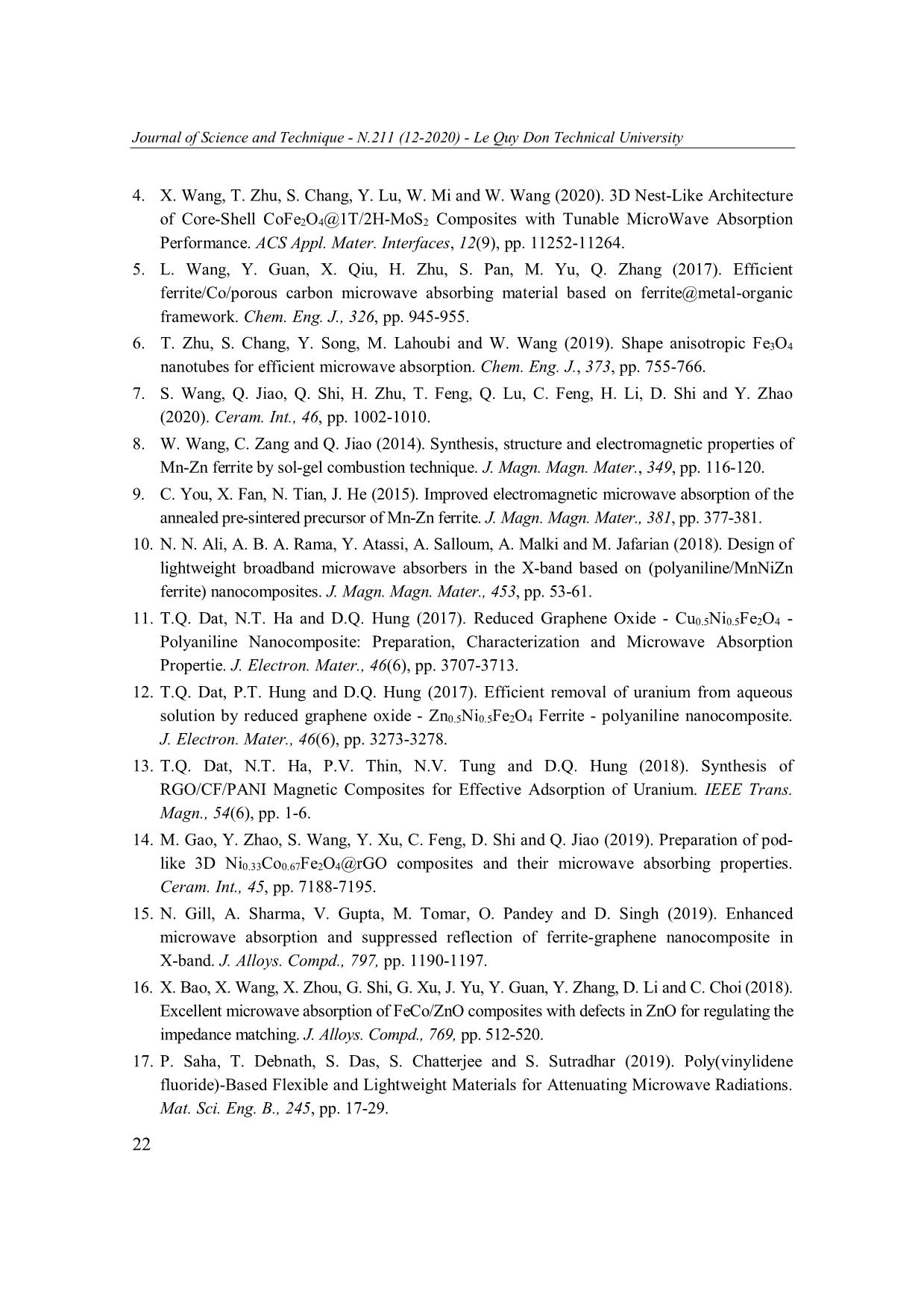
Trang 10
Tải về để xem bản đầy đủ
Tóm tắt nội dung tài liệu: Synthesis of reduced graphene oxide - Mn₀.₈Zn₀.₂Fe₂O₄ - porous polyaniline nanocomposite materials for effective microwave absorption in X-band
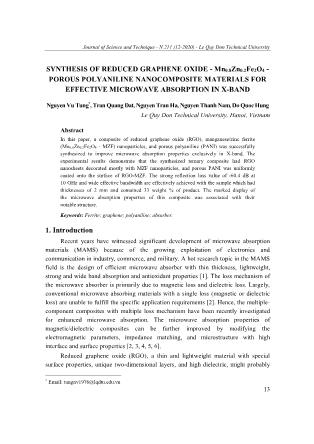
Journal of Science and Technique - N.211 (12-2020) - Le Quy Don Technical University SYNTHESIS OF REDUCED GRAPHENE OXIDE - Mn0.8Zn0.2Fe2O4 - POROUS POLYANILINE NANOCOMPOSITE MATERIALS FOR EFFECTIVE MICROWAVE ABSORPTION IN X-BAND Nguyen Vu Tung*, Tran Quang Dat, Nguyen Tran Ha, Nguyen Thanh Nam, Do Quoc Hung Le Quy Don Technical University, Hanoi, Vietnam Abstract In this paper, a composite of reduced graphene oxide (RGO), manganese/zinc ferrite (Mn0.8Zn0.2Fe2O4 - MZF) nanoparticles, and porous polyaniline (PANI) was successfully synthesized to improve microwave absorption properties exclusively in X-band. The experimental results demonstrate that the synthesized ternary composite had RGO nanosheets decorated mostly with MZF nanoparticles, and porous PANI was uniformly coated onto the surface of RGO-MZF. The strong reflection loss value of -60.4 dB at 10 GHz and wide effective bandwidth are effectively achieved with the sample which had thicknesses of 2 mm and contained 33 weight % of product. The marked display of the microwave absorption properties of this composite was associated with their notable structure. Keywords: Ferrite; graphene; polyaniline; absorber. 1. Introduction Recent years have witnessed significant development of microwave absorption materials (MAMS) because of the growing exploitation of electronics and communication in industry, commerce, and military. A hot research topic in the MAMS field is the design of efficient microwave absorber with thin thickness, lightweight, strong and wide band absorption and antioxidant properties [1]. The loss mechanism of the microwave absorber is primarily due to magnetic loss and dielectric loss. Largely, conventional microwave absorbing materials with a single loss (magnetic or dielectric loss) are unable to fulfill the specific application requirements [2]. Hence, the multiple- component composites with multiple loss mechanism have been recently investigated for enhanced microwave absorption. The microwave absorption properties of magnetic/dielectric composites can be further improved by modifying the electromagnetic parameters, impedance matching, and microstructure with high interface and surface properties [2, 3, 4, 5, 6]. Reduced graphene oxide (RGO), a thin and lightweight material with special surface properties, unique two-dimensional layers, and high dielectric, might probably * Email: tungnv1976@lqdtu.edu.vn 13 Journal of Science and Technique - N.211 (12-2020) - Le Quy Don Technical University be one of the best microwave absorbers [3]. However, RGO has weak magnetic loss property and high conductivity, therefore exhibiting limited microwave absorption performance [7]. The microwave absorption properties of RGO can be enhanced by incorporating magnetic ferrite nanoparticles onto the surface of RGO nanosheets as demonstrated in [3]. Among the popular magnetic ferrite, manganese/zinc ferrite spinel materials have been explored as microwave absorbent due to their high permeability, adequate mechanical, and low dielectric loss [8, 9]. Recently, polyaniline (PANI) has emerged as one of the most promising materials for microwave absorption applications. Compared to other microwave absorbers, PANI embodies several notable features, including unique electromagnetic parameters in ultrahigh radio-frequencies, low density, processability, complete resistance to corrosion, and excellent environmental stability. Indeed, PANI has been widely considered as a promising alternative to traditional MAMS for enhanced microwave absorption [10]. In our previous reports, RGO - copper/nickel ferrite - PANI composites have been prepared and tested for microwave absorption enhancement [11]. In this work, ternary composites composed of RGO, manganese/zinc ferrite (Mn0.8Zn0.2Fe2O4 - MZF) and porous PANI are developed. The porous structure of PANI in the ternary composites is envisaged to offer new energy dissipation mechanisms, thus leading to significant enhancement in the microwave absorption performance of the ternary composites. 2. Experimental 2.1. Synthesis of the composite All chemicals used in this work are analytical grade. Solutions were prepared with deionized water (DI). RGO was synthesized from graphite powder using the modified Hummers method [11, 12, 13]. The RGO/MZF composite was synthesized by coprecipitation combined with hydrothermal treatment. Firstly, a mixture of 60 mL of ethylene glycol, 40 mL of DI water, 4.0 mmol of Fe(NO3)3, 1.6 mmol of MnCl2, and 0.4 mmol of Zn(NO3)2 was prepared (i.e. with agitation at room temperature for 1 h). Then, RGO powder was slowly added to the mixture following with another 1 h of agitation. Subsequently, 4 mL of NH3 solution (25%) was dropped into the mixture. The coprecipitation reaction occurred in 4 h under continuous agitation. The suspension after the coprecip ... RGO. In Fig. 3b, the peak at 539 cm-1 could be recognized to the vibration of Fe-O bond. Besides, the peak at 1639 and 1430 cm-1 corresponds to the C=C stretching vibration and O-H deformation. In Fig. 3c, the vibration of Fe-O bond is found at 575 cm-1. The peaks at 798 and 1045 cm-1 are associated with the stretching vibration mode of C-H bond and C-O bond, respectively. The vibrations of C-N bonds located at 1242 and 1296 cm-1. The peaks at 1496 and 1590 cm-1 could be attributed to the vibration of C=C stretching of benzenoid and quinonoid rings [11, 13]. The XRD pattern and FTIR spectra demonstrate that RGO, MZF, and PANI exist in this composite. The RGO/MZF/PANI magnetic hysteresis loop at room temperature is shown in Fig. 4. The hysteresis loop of composite displays that the remanence and coercive force are near zero. This result indicated that obtained composite was typically superparamagnetic-like. The maximum value of magnetizatio n of RGO/MZF/PANI composite is about 48 emu/g. The high saturation magnetization implies that the 17 Journal of Science and Technique - N.211 (12-2020) - Le Quy Don Technical University composite has the natural resonance loss and the eddy current loss which is responsible for increasing the magnetic loss [14]. 60 40 20 0 4 2 (emu/g) M -20 0 -2 M (emu/g) M -40 -4 -40 -20 0 20 40 H (Oe) -60 -10000 -5000 0 5000 10000 H (Oe) Fig. 4. Room temperature magnetic hysteresis loops of RGO/MZF/PANI. 3.2. Microwave absorption properties of composites The microwave absorption properties of absorbers are related closely with the real and imaginary parts of complex permittivity and complex permeability. Fig. 5 shows these frequency-dependent values of the sample with thickness of 2.0 mm. It can be seen from this figure, the values of both the real part (µ’) and imaginary part (µ”) of relative complex permeability remain almost constant with slight variations. The gradual decrease of the real part (’) and imaginary part (”) of relative complex permitivity in 8-12 GHz band is observed. The high values of ’ is certified to the improvement of dipolar polarization and interfacial polarization. Furthermore, the high ” value is correlated to the low resistivity which related to the efficient electronic transmission performance in the composite [15]. 16 1.2 e' e'' m' m'' tande tand 1.0 m 12 0.8 8 0.6 0.4 4 0.2 Permitivity,permeability 0 0.0 8 9 10 11 12 tangent loss Electromagetic 8 9 10 11 12 Frequency (GHz) f (GHz) Fig. 5. The real, imaginary part of complex Fig. 6. The dielectric and magnetic loss permittivity and complex permeability of tangent of RGO/MZF/PANI. RGO/MZF/PANI. 18 Journal of Science and Technique - N.211 (12-2020) - Le Quy Don Technical University Generally, the dielectric loss (tan e = ’’/’) and magnetic loss (tan m = µ’’/µ’) are the major energy attenuation in microwave absorbers. The magnetic loss tangent and dielectric loss tangent were calculated and presented in Fig. 6. Here, the value of tan e is larger than that of tan m in the whole frequency range, which indicates that the dielectric loss has the significant contribution to electromagnetic loss of the composite. It is known that the heterogeneous interfaces among RGO, porous PANI and MZF ferrite could create more polarization centers under the external electromagnetic field, which would increase interfacial polarization and improve related relaxation. According to Debye theory [11], one relaxation process can express as following equation: 2 2 s 2 s ' '' (3) 2 2 where s, are the static permittivity and the relative permittivity at the high-frequency limit. 10 0.010 9 0.005 0 C '' e 8 0.000 7 -0.005 9 10 11 12 13 8 9 10 11 12 e' f (GHz) Fig. 7. The typical Cole-semicircle curve Fig. 8. The C0 - f values of RGO/MZF/PANI. of RGO/MZF/PANI. The curve of ε’’ versus ε’ is called the Cole-Cole semicircle. In Fig. 7, multiple distinct semicircles can be observed, which indicates that the multi-dielectric relaxation process occurs in the RGO/MZF/PANI composite. Furthermore, the distorted Cole-Cole semicircles could be related to other factors, such as the electron polarization, Maxwell- Wagner relaxation and dipole polarization, which will also generate other mechanisms to enhance the dielectric loss [2]. The magnetic loss due to eddy currents can be estimated by the coefficient C0 2 defined as C0 = ’’/(’ .f), where f is frequency. It can be seen from Fig. 8, the value of C0 changes slightly with frequency. This result suggests that the magnetic loss of the composite is mainly caused by the eddy current effect in X-band. To study the physical mechanism of the microwave absorption, the impedance 1/2 matching ratio is conducted. It is defined as = (µr/r) . The best impedance matching ratio is equal to 1. From Fig. 9, the value of cannot reach 1 and its maximum is 0.324 at 10 GHz in X-band. 19 Journal of Science and Technique - N.211 (12-2020) - Le Quy Don Technical University Fig. 10 displays the microwave reflection loss (RL) as function of frequency for the RGO/MZF/PANI samples with thicknesses of 1.5, 2.0, 2.5 and 3.0 mm, respectively. It can be seen from this figure that the effective absorption bandwidth of these samples covered wholly the X-band. In addition, as the thickness of the sample increases, the shift of the absorption peaks which move towards the lower frequency, will be also observed. The best minimum RL is -60.4 dB at a frequency of 10 GHz. 0.4 0 -10 (dB) -20 -30 0.3 -40 -50 d = 1.5 mm d = 2.0 mm Reflection Loss Reflection -60 d = 2.5 mm Impedance matching ratio d = 3.0 mm 0.2 -70 8 9 10 11 12 8 9 10 11 12 f (GHz) f (GHz) Fig. 9. The impedance matching ratio of Fig. 10. Reflection loss of RGO/MZF/PANI. RGO/MZF/PANI. Table 1 presents the comparison of microwave absorption properties of RGO/MZF/PANI composite with other reported binary and ternary ferrite-based composites. You et al. [9] synthesized MnZn particles which had the absorption bandwidth of 3.5 GHz with the best RL value of -18 dB (in X-band). Shen et al. [3] prepared RGO/Co0.8Fe2.2O4 composite and reported that the RL could reach -33 dB with the sample 2.5 mm. The ternary composite RGO/CoFe2O4/MWCNT reported by Zhang et al. [19] had the minimum RL at 11.6 GHz of -46.8 dB and narrow absorption bandwidth of 1.9 GHz. The RGO/CNF/PANI composite [11] had the optimal RL value can reach -40.7 dB at 9.8 GHz with a thickness of 3 mm and the effective wideband in X-band. By comparing these results, the RGO/MZF/PANI composite exhibits excellent microwave absorption performance with high reflection loss, wide effective absorption bandwidth and thin thickness. The excellent microwave absorption performance of the RGO/MZF/PANI composite is associated to its structure original and composition. RGO and PANI are well known as impressive dielectric loss materials [11]. Second, the MZF nanoparticles in composite are combined to RGO and PANI to form substantial interfaces, centers polarization [3, 10]. Third, the 2-D structure of RGO can lead to other mechanisms of energy dissipation, such as multiple reflection plane, the oscillations of magnetic nanoparticles in electromagnetic field and the electron hopping in the conductive 20 Journal of Science and Technique - N.211 (12-2020) - Le Quy Don Technical University network [7, 19]. In addition, the porous structure of PANI nano fiber is also attributed to the improvement of the microwave attenuation due to the large specific area and 3-D network structure. Tab. 1. Comparison of the microwave absorption properties with other absorbers. RLmin Bandwidth Thickness Absorber Ref. (dB@frequency) in X-band (GHz) (mm) RGO/SmFe5O12/CoFe2O4 -63.3 @ 11.1 GHz 3.0 3.0 [2] RGO/Co0.8Fe2.2O4 -33 @ 9.0 GHz 4.0 2.5 [3] CoFe2O4/MoS2 -35 @ 9.0 GHz 2.3 2.5 [4] BaSmCoFe/Co/Carbon -28 @ 10.2 GHz 2.8 2.0 [4] RGO/CoFe2O4/PVP -25 @ 9.0 GHz 3.5 3.0 [6] -Fe2O3 NR/PNG -35 @ 10.0 GHz 2.3 2.0 [7] MnZn ferrite -18 @ 9.5 GHz 3.5 2.4 [9] MnZnNi ferrite/PANI -39 @ 9.25 GHz 2.8 3.5 [10] RGO/CNF/PANI -40.7 @ 9.8 GHz 4.0 3.0 [11] 3D Ni0.33Co0.67Fe2O4@RGO -47.5 @ 9.0 GHz 3.0 3.0 [14] FeO/ZnO -26 @ 10.5 GHz 3.0 2.0 [16] Mn-Zn-Cu ferrite/PVDF thin film -33.5 @ 11.5 GHz 4.0 - [17] CIP@SiO2@Mn0.6Zn0.4Fe2O4 -44.24 @ 11.57 GHz 3.0 2.0 [18] RGO/CoFe2O4/MWCNT -46.8 @ 11.6 GHz 1.9 1.6 [19] PANI/ZnO/CoFe2O4 -41.9 @ 10.3 GHz 3.3 3.0 [20] This RGO/MZF/porous PANI -60.4 @10.0 GHz 4.0 2.0 work 4. Conclusion In this work, the reduced graphene oxide-manganese/zinc ferrite-porous polyaniline composites have been successfully synthesized by a three-step method. The structural and morphology analyses (e.g. SEM, XRD, FTIR, and VSM technique) demonstrated that fine synthesized RGO and MZF particles and porous PANI were uniformly distributed. Moreover, the synthesized composites exhibited strong absorption and a wide absorption bandwidth. The minimum RL value was -60.4 dB at 10 GHz with a thickness of 2.0 mm and the effective absorption bandwidth wholly covered the X-band. Therefore, the nanocomposite of RGO/MZF/PANI would be highly suitable for the promising microwave absorbers. References 1. F. Meng, H. Wang, F. Huang, Y. Guo, Z. Wang, D. Hui and Z. Zhou (2018). Graphene-based microwave absorbing composites: A review and prospective. Compo. B. Eng., 137, pp. 260-277. 2. W. Shen, B. Ren, S. Wu, W. Wang and X. Zhou (2018). Facile synthesis of rGO/SmFe5O12/CoF2O4 ternary nanocomposites: Composition control for superior broadband microwave absorption performance. Appl. Surf. Sci., 453, pp. 464-476. 3. Wei. Shen, B. Ren, K. Cai, Y. Song and W. Wang (2019). Synthesis of nonstoichiometric Co0.8Fe2.2O4/reduced graphene oxide (rGO) nanocomposites and their excellent electromagnetic wave absorption property. J. Alloys. Compd., 774, pp. 997-1008. 21 Journal of Science and Technique - N.211 (12-2020) - Le Quy Don Technical University 4. X. Wang, T. Zhu, S. Chang, Y. Lu, W. Mi and W. Wang (2020). 3D Nest-Like Architecture of Core-Shell CoFe2O4@1T/2H-MoS2 Composites with Tunable MicroWave Absorption Performance. ACS Appl. Mater. Interfaces, 12(9), pp. 11252-11264. 5. L. Wang, Y. Guan, X. Qiu, H. Zhu, S. Pan, M. Yu, Q. Zhang (2017). Efficient ferrite/Co/porous carbon microwave absorbing material based on ferrite@metal-organic framework. Chem. Eng. J., 326, pp. 945-955. 6. T. Zhu, S. Chang, Y. Song, M. Lahoubi and W. Wang (2019). Shape anisotropic Fe3O4 nanotubes for efficient microwave absorption. Chem. Eng. J., 373, pp. 755-766. 7. S. Wang, Q. Jiao, Q. Shi, H. Zhu, T. Feng, Q. Lu, C. Feng, H. Li, D. Shi and Y. Zhao (2020). Ceram. Int., 46, pp. 1002-1010. 8. W. Wang, C. Zang and Q. Jiao (2014). Synthesis, structure and electromagnetic properties of Mn-Zn ferrite by sol-gel combustion technique. J. Magn. Magn. Mater., 349, pp. 116-120. 9. C. You, X. Fan, N. Tian, J. He (2015). Improved electromagnetic microwave absorption of the annealed pre-sintered precursor of Mn-Zn ferrite. J. Magn. Magn. Mater., 381, pp. 377-381. 10. N. N. Ali, A. B. A. Rama, Y. Atassi, A. Salloum, A. Malki and M. Jafarian (2018). Design of lightweight broadband microwave absorbers in the X-band based on (polyaniline/MnNiZn ferrite) nanocomposites. J. Magn. Magn. Mater., 453, pp. 53-61. 11. T.Q. Dat, N.T. Ha and D.Q. Hung (2017). Reduced Graphene Oxide - Cu0.5Ni0.5Fe2O4 - Polyaniline Nanocomposite: Preparation, Characterization and Microwave Absorption Propertie. J. Electron. Mater., 46(6), pp. 3707-3713. 12. T.Q. Dat, P.T. Hung and D.Q. Hung (2017). Efficient removal of uranium from aqueous solution by reduced graphene oxide - Zn0.5Ni0.5Fe2O4 Ferrite - polyaniline nanocomposite. J. Electron. Mater., 46(6), pp. 3273-3278. 13. T.Q. Dat, N.T. Ha, P.V. Thin, N.V. Tung and D.Q. Hung (2018). Synthesis of RGO/CF/PANI Magnetic Composites for Effective Adsorption of Uranium. IEEE Trans. Magn., 54(6), pp. 1-6. 14. M. Gao, Y. Zhao, S. Wang, Y. Xu, C. Feng, D. Shi and Q. Jiao (2019). Preparation of pod- like 3D Ni0.33Co0.67Fe2O4@rGO composites and their microwave absorbing properties. Ceram. Int., 45, pp. 7188-7195. 15. N. Gill, A. Sharma, V. Gupta, M. Tomar, O. Pandey and D. Singh (2019). Enhanced microwave absorption and suppressed reflection of ferrite-graphene nanocomposite in X-band. J. Alloys. Compd., 797, pp. 1190-1197. 16. X. Bao, X. Wang, X. Zhou, G. Shi, G. Xu, J. Yu, Y. Guan, Y. Zhang, D. Li and C. Choi (2018). Excellent microwave absorption of FeCo/ZnO composites with defects in ZnO for regulating the impedance matching. J. Alloys. Compd., 769, pp. 512-520. 17. P. Saha, T. Debnath, S. Das, S. Chatterjee and S. Sutradhar (2019). Poly(vinylidene fluoride)-Based Flexible and Lightweight Materials for Attenuating Microwave Radiations. Mat. Sci. Eng. B., 245, pp. 17-29. 22 Journal of Science and Technique - N.211 (12-2020) - Le Quy Don Technical University 18. Q. Chen, L. Li, Z. Wang, Y. Ge, C. Zhou and J. Yi (2019). Synthesis and enhanced microwave absorption performance of CIP@SiO2@Mn0.6Zn0.4Fe2O4 ferrite composites. J. Alloys. Compd., 779, pp. 720-727. 19. K. Zhang, X. Gao, Q. Zhang, T. Li, H. Chen and X. Chen (2017). Preparation and microwave absorption properties of asphalt carbon coated reduced graphene oxide/magnetic CoFe2O4 hollow particles modified multi-wall carbon nanotube composites. J. Alloys. Compd., 723, pp. 912-921. 20. Y. Lin, J. Wang, H. Yang and L. Wang (2017). In situ preparation of PANI/ZnO/CoFe2O4 composite with enhanced microwave absorption performance. J. Mater. Sci.: Mater. Elec., 28(23), pp. 17968-17975. CHẾ TẠO VẬT LIỆU NANOCOMPOSITE RGO - Mn0.8Zn0.2Fe2O4 - POLYANILIN XỐP HẤP THỤ HIỆU QUẢ VI SÓNG BĂNG TẦN X Tóm tắt: Trong bài báo này, composite bao gồm reduced graphene oxide (RGO), hạt nano mangan/kẽm ferrite (Mn0.8Zn0.2Fe2O4 - MZF) và polyanilin xốp (PANI) đã được tổng hợp nhằm cải thiện các đặc tính hấp thụ vi sóng trong dải băng X. Kết quả cho thấy các tấm nano RGO đã được phủ bởi các hạt nano MZF và các sợi PANI được phủ đồng đều lên trên bề mặt của cấu trúc RGO-MZF. Giá trị tổn hao phản xạ đạt được là -60,4 dB tại tần số 10 GHz và dải băng hấp thụ rộng ứng với mẫu có bề dày 2 mm và chứa 33% khối lượng của composite. Các đặc tính cải thiện về khả năng hấp thụ sóng có tương quan với thành phần, cấu trúc của vật liệu composite. Từ khóa: Ferrite; graphene; polyanilin; vật liệu hấp thụ. Received: 04/6/2020; Revised: 20/11/2020; Accepted for publication: 26/11/2020 23
File đính kèm:
 synthesis_of_reduced_graphene_oxide_mn_zn_feo_porous_polyani.pdf
synthesis_of_reduced_graphene_oxide_mn_zn_feo_porous_polyani.pdf

